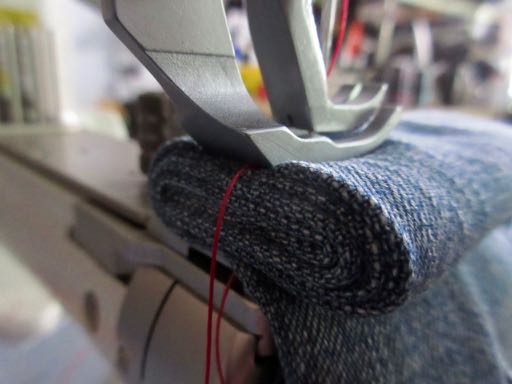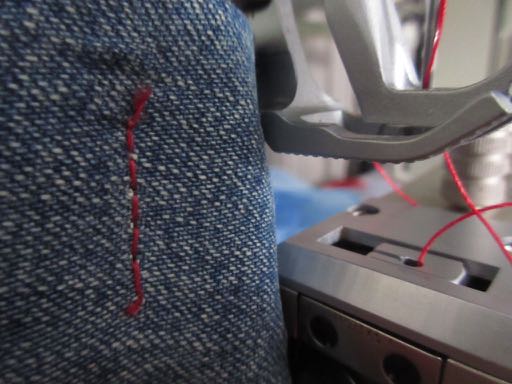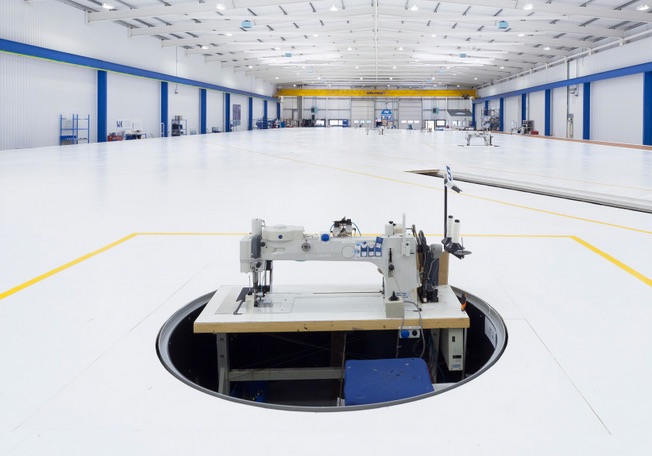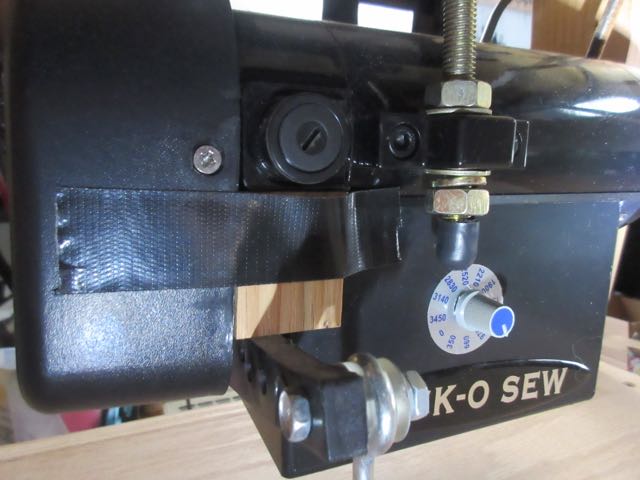-
Posts
40 -
Joined
-
Last visited
Content Type
Profiles
Forums
Events
Blogs
Gallery
Everything posted by coryleif
-

New Tandy Craftool Pro Stitch Master made by Sailrite
coryleif replied to Treesner's topic in Leather Sewing Machines
Kj4700, If a machine has teeth, it's going to to mark the leather. The Fab takes a Singer 111-style foot, so there are a lot of options in that dept. (e.g. https://www.sailrite.com/Leather-Foot-Set-for-Fabricator-Sewing-Machine), but here's what the feed dog looks like: https://www.sailrite.com/Feed-Dog-for-Sailrite-111 Pretty toothy. Sailrite is more canvas-focused as a company; I don't see an option for a smooth feed dog or a slotted needle plate that removes the feed dog from the equation. The Fabricator/Tacsew 111 is not as common as, say, a Consew 206 or Juki 1541, so feed-dog options might be limited. I would call Bob or Gregg, who commented above, and see what your options are for smoothing things out. Good luck, happy sewing! -
-

Singer 114W103 Chainstitch Embroidery Machine
coryleif replied to GPaudler's topic in Leather Sewing Machines
Thanks for the story and plate info, Gregg! One of these days I'll try setting up my 20U with this. Sadly I bought a new one before I knew any better. Maybe some day I'll get one of those sexy blue ones. Hey, the hook was still made in Japan! Anyway, for people looking for more info on the Singer 114w103, Consew 104, and any other Cornely or bonnaz embroidery machine, there's now a real nice Facebook group: https://www.facebook.com/groups/WQW.AMC/?fref=mentions It is a closed group, but you don't have to own a machine to get in. Sometimes members post machines for sale. -
A used made-in-Japan (by Seiko) Consew 289 will run you 2000+ USD depending on condition. Still in production, but probably made in China now? http://www.consew.com/List/Lockstitch-Sewing/Post-Bed
-
Last year I picked up some grease for my Singer 15-90 motor: https://singer-featherweight.com/products/sew-retro-grease?variant=18303537283 Some interesting info on melting points. Been using it on the gears of my Consew 207 and 104 to see how it holds up. So far okay -- but I'm not sewing a whole lot on 'em. Hafta check out the Tri-Flow. "I saw where Uwe recommended tri-flow for the gears, but they make 2 kinds..." I assume the TF clear grease is what people are using: https://www.amazon.com/Tri-Flow-TF23004-Clear-Synthetic-Grease/dp/B000C15MUU/ https://www.triflowlubricants.com/wheretobuy
- 28 replies
-
- grease
- industrial sewing machine
-
(and 1 more)
Tagged with:
-
Maybe check out what Seiko has to offer: http://www.seiko-sewing.co.jp/en/products/lhpwnseries/ 16mm lift, has a listed needle size of #25, which puts you at a max of 207, most likely On the heavier side, Cowboy (one of the sponsored brands on this forum) offers a machine that will take up to a 26 needle, 20mm lift, and has a barrel-shuttle hook. Made in China. http://cowboysew.com/product6.htm
-

recomendations for a good heavy duty, walking foot, zig zag
coryleif replied to mixmkr's topic in Leather Sewing Machines
That was a photo of one of North Sails' lofts. Attached is another one. I assume the machine is on the floor and the rest of the room is one huge table. Wish I had that much sewing space. I wonder if these are Solent machines. I'm assuming they're more than 4k. Scroll to the bottom for more huge machines: http://www.nauticexpo.com/prod/solent-sewing-machines-ltd/product-38112-420079.html BTW, mixmkr, I have a 2-point/1-step Sailrite Pro, which is their copy of the Consew 146, if you need any action shots. Looks like they're going for 2.3k right now. c -

recomendations for a good heavy duty, walking foot, zig zag
coryleif replied to mixmkr's topic in Leather Sewing Machines
Whatever you get, make sure you can crawl under the arm: -
Daaaang! that's some cool felt! Too spendy to buy for wicks, I would think, and "the surface has a waxy coating that repels liquids. Water droplets on the surface will bead and roll off instead of being absorbed into the fabric." [https://www.filzfelt.com/index.php?/faq] Now I want some. Thanks, Uwe!
-
I've also removed all the brakes from my motors. On some, this'll cause the lever to move up, increasing the amount of pedal movement needed before engagement. I slap a piece of wood on there to tighten up the action.
-
I've bought three machines from them -- two used, one new. The used machines needed some work. The post-bed machine was resting on the oil pan and was shimmed up with extra corner pads. Needed a new bobbin spring, tension assembly ... and probably some other stuff I haven't found yet. Still haven't used it a whole lot since it still has some issues. Not real impressed with that. Had "4:30 on Friday" written all over it. Serger needed some presser-foot tweaks and new needle set-screws that were rounded out. And a de-glittering (came out of a dance-wear factory). When I got the new machine they took the time to show me how to use it and made some minor adjustments for me. Nick and his crew are very nice and responsive. Just wish I hadn't had to call on 'em so many times after purchasing the machines. The guys at the St Louis shop are great to talk to -- and have a lot of experience in the trade. Not so much with leatherwork, though. It's a pretty big operation, seems, and growing. I understand that things fall though the cracks. Their prices are great, and it's nice to be able to look at machines in person. I'll get my next machine from Cowboy Bob or Techsew Ron, though. Unless Uwe finds another one of those used patchers, in the long-arm variety. See also: Just my $0.02. cory
-

Best machine-sewing video tutorials?
coryleif replied to soccerdad's topic in Leather Sewing Machines
I get a kick outta the Springfield Leather video: www.youtube.com/watch?v=mU4bLRelCtA Here are some basic skills from Al Bane: www.youtube.com/watch?v=fhhAV7nVLSY -
I find this to be a pretty oily machine. Before I start sewing, I wipe down everything that might come in contact with the material -- even the bed by the uprise seems to get oil on it -- and sew on some scrap material or a paper towel till the oil's gone. After that, you should be good for the day. I find that most of my machines will have some oil hanging on the needle after they've been sitting for a while. This'll get the thread oily, too. But maybe I'm oiling them too much. If you think it's pumping too much oil, there's a little plate by the pump screen that can be adjusted (slide it open for less oil, I believe). It's in the manual. Let me know if you need a picture of it. Good luck! c
-

puckers in waxed canvas stitching
coryleif replied to georgeandgracie's topic in Leather Sewing Machines
Here're some more tips on puckering from the folks at Sailrite (mostly reinforcing what's been said above): https://sailrite.wordpress.com/2015/04/09/how-to-keep-fabric-from-shrinking-when-you-sew/ I second the Ventile spec info. Came across that years ago and it's been helpful. Eric, if you don't mind sharing, what kind of cotton-wrapped poly thread are you guys using? I've been looking at A&E's D-Core for denim totes, and wondering if there's anything better. Re used machines: it's always best to try out used machines, if possible ... unless you're buying it from Uwe. Also, check out the LW.net sponsors -- many deal in used machines. See also Keystone Sewing and Nick-O Sew. Good luck, happy sewing! c -

Show & Tell: Building A Shipping Crate For An Adler 69
coryleif replied to Uwe's topic in Leather Sewing Machines
I bought a Juki 241 off eBay about 6 years ago. It was from a liquidation outfit and turned out they had no idea how to ship a sewing machine: Parts of the machine were sticking through the box and the needle positioner had exploded. It would've been better if they'd shipped it in a burlap sack. This machine's still on the "I'll deal with it later" list. -
Great advice. Thanks, Eric! [c]
-
Thanks, Eric! After this, I also make sure to oil the hook every time I sew. This happened to me the first day I had this new machine. Maybe the hook needed to break in and I pushed it too hard. I think there's a Kurt Vonnegut short story related to that... Do you adjust the finger/notch position based on what looks or sounds good? The finger on my Tacsew 111 goes in about 1.5mm -- enough for the bobbin basket not to pop out, but with plenty of room for #92 thread to move freely. I guess what I'm asking is: what's too close? Do you see people push the finger in far enough to obstruct the thread? Thanks again! [c]
-
Hi Gregg, My 1541S does this sometimes, too. I've found that if pressure is applied to the bobbin, the basket and hook will lock up, causing the assembly to pop out of position like in Piera's case above. While sewing, this happens while stitching thick items w/o adjusting the thread guides to allow for more thread to go around the bobbin (causing the thread to push on the basket and jamming). I got Juki to give me a new hook and it's a little bit better, but I'm always vigilant about properly adjusting the thread guides now. Bad hook batch or just bad case finger adjustment? Thanks! cory
-

Where Is The Best Place To Get Sewing Machine Thread?
coryleif replied to HVLW's topic in Leather Sewing Machines
Ken, Perfect Fit has T90 Coats Ultra Dee in Peasant Beige (and a ton of other colors). Star is very similar to their Dabond line: http://perfectfit.com/15355/154563/Thread-and-Bobbins/Coats-Bonded-Polyester-Thread--4-oz-Spools----Size-DB--92.html I've been talking to A&E about ordering directly from them. I received a cotton/poly color chart and quotes for a lightweight project, but haven't ordered yet (and still need to see what their minimums are). I also plan on trying their Anefil Poly to see how it compares to the Coats I use. It's available in T16 to 700. http://www.amefird.com/products-brands/industrial-sewing-thread/ HVLW, I think the T90 from Coats above would be fine for wallets -- it depends on how much you want the thread to pop. I'd say wallets: T70 - T90; purses: T90 - T135, but maybe heavier for decorative topstitching and type of leather/fabric used. -

Tacsew 111 Thread Catching In Reverse
coryleif replied to coryleif's topic in Leather Sewing Machines
Thanks for the help, guys! I've had this machine for about 9 years, and while it gets pretty light use for an industrial, I wouldn't be surprised if something has drifted. This machine actually has a gear-driven hook. While it's called a 111-155, it's different in many ways from the Singer 111w155. Way to be weird, Tacony. Thanks for the graphic, Uwe. It does look like the hook is a little slow. I'd say it's at about 7 o'clock instead of six. Though, there's plenty of thread available to go round the bobbin (check spring looks okay, thread guides' adjustment has no effect); it's just hanging on that basket lip ... but if it had more thread maybe it wouldn't do that. Catskin, I have checked for a burr. And like I said above, it is catching on the edge of the bobbin basket where there's a groove/lip. I wonder if I shaved that off it would do the trick. Thanks again, everyone! I'll keep ruminatin' on it and take a harder look at the hook position. I'm in the middle of a project, so I won't make any adjustments till I'm done. c -
So my T111-155 has been making this clicking sound for years (maybe forever) while sewing heavier materials in reverse. I finally took the time to suss out the source of the noise. This is what I observed: The top thread is catching on the edge of the bobbin basket while it goes around the bobbin. There's a li'l ridge or lip on it. Since it's sewing in reverse, the feed dog is travelling forward (opposite direction of hook) while the thread is going around and so lines the thread up on this ridge, where it hangs, and causes the thread to hang on the bobbin case, too ... and then it pops free. Here's a li'l video (the first few stitches are forward stitches): I think it's only broken a couple stitches in its life. I just got some thread lube and I imagine that will help. Timing seems pretty good. Don't think it's ever skipped. Stitch length here is about 5/inch here. Reverse is slightly longer. I'm still looking into feed dog position and such, and will take a harder look at timing at some point, but thought I'd toss up this document for posterity. Fun stuff.
-

Source For 206Rb5? (Should I Consider A Different Machine?)
coryleif replied to Dougster's topic in Leather Sewing Machines
See also the Seiko STH-8BLD-3. Same as the Consew 206, but made in Japan. Check out the Juki 1541, too. Li'l cheaper than the 1508 (but a horizontal-axis hook, like the 206). Also from Gregg: http://store.keysew.com/catalog/product/9734e551a7b84990b24431b3edd65d91 I ordered my 335 from Zamir. It was drop-shipped in fine working order. Though, the binding attachment he sold me didn't work with the machine. Also, he told me these were still made in Germany. They are not. Lesson learned. Follow Wiz's advice below. [c] -

Random Loose Top Thread Consew 289Rb-1
coryleif replied to coryleif's topic in Leather Sewing Machines
Thanks, guys! I'll start experimenting with different thread and see what I can see. I'll also look into that silicon lube -- that seems promising. [Now that I think of it, the bottom thread guide has a felt pad in it -- that's probably for lube. ] This is Coats Ultra Dee thread, which I got from an upholstery supplier. I've had good luck with it over the years. Though, like I said, it's not exactly new. It's curious that this doesn't happen with my other machine (Tacsew 111) with the exact same thread and material. I'll keep diggin'. Thanks again! cory -

Random Loose Top Thread Consew 289Rb-1
coryleif replied to coryleif's topic in Leather Sewing Machines
Thanks for the quick and thorough response, Uwe! That is my blog (thanks again) ... which, now that I think about it, is mostly about my terrible luck with machines. My Singer 20U also does this sometimes. With that machine, I suspect it is also the foot preventing the stitch from setting after it's popped up. I have the newer Chinese-flavored machine. I was checking out one of those sexier blue 20Us and noticed that its regular foot has a beveled underside behind the opening that would allow the stitch to set w/o interference. The new foot on my machine has a comparatively hard edge. I've recently got a teflon foot and cut it out underneath a bit with good results ... but I digress... Yes, this is a super-cool machine, especially for bagmaking. I didn't know I needed one till I saw how they make L.L. Bean totes. Maybe I was a little too eager to get it ... and overlooked some of its faults. Ha. This happens at speed (though I don't sew very fast) and hand cranking. I haven't been able to catch it at just the right moment yet and inspect all the thread paths. To clarify: the top thread pops up after the needle has exited the fabric. Seems to be a thread-on-thread situation, somewhere after the 46-second mark on your video, before the knot is pulled up. If you can imagine that both sides of the top-thread loop are moving up through the material at 0:49, I think that's what's going on. 1. #20/T90 is a pretty standard thread combo. I use it w/o issue on my other machines. This Sunbrella has a pretty tight weave, though, so maybe a larger needle might help. 2. Since the thread is black, it's a little on the rough side. It's not super fresh either, so lube might help. Do you have a preferred type/source for canvaswork? 3. The take-up lever looks okay. Though, that's good to know how to time it properly. Always been a bit of a mystery to me. 4. Without removing the feed dog, the timing seems pretty good (but I don't think the needle is kissing the guard). I've never had any skipped stitches; though I did have a backlash-related jam (I think) ... but I might've had the bobbin in backwards. Still haven't looked into the latch-opener timing enough. The feed-dog hole is chewed up a bit. I should probably smooth it out. Something could be getting caught in there. I might shave off the heel of that foot so it's not pressing so much on the stitch. We'll see. Thanks for your help, Uwe! I've been spending most of my Internet time on this forum these days (years) and I have to say, your videos are a nextlevel addition. I wish I knew what I know now 10 years ago. And there's still so much to learn... cory -
Hi guys, Before I continue tinkering with my machine, I thought I'd see if anyone has had this problem before and can offer a solution. I have a new-to-me compound-feed post-bed machine. Sometimes it sews fine more miles, sometimes it throws out random loose stitches on the top thread (see photo), usually when I'm sewing the finishing stitches on a bag. Seems like what's causing this is: after the stitch has been made and the needle is coming up and the take-up lever is pulling up the top thread and the bobbin thread into the fabric, the top thread rubs against itself and pulls up a top-thread loop. Usually everything is pulled back down tight before the center presser foot comes down, but it looks like sometimes the foot stomps on the loop and keeps it there. Is this simply a top-thread tension issue, or is there something more sinister at play? In the photo, I'm sewing with T90 bonded poly thread (black), #20/125 needle, on acrylic (Sunbrella) canvas. This machine came set up for leatherwork, but I have it set up for canvas currently. It had this problem when I got it, though (with a heavier needle/thread setup and with cotton canvas). For canvas sewing, I have replaced the thread tension assembly, the bobbin spring, and switched out the feet. The bobbin is rotating opposite the direction of the hook. There is no anti-backlash mechanism. I'm still working on getting the bobbins wound evenly; the bobbin winder supplied was set up for a much smaller bobbin than the 289's U bobbins. Thanks for reading! cory










